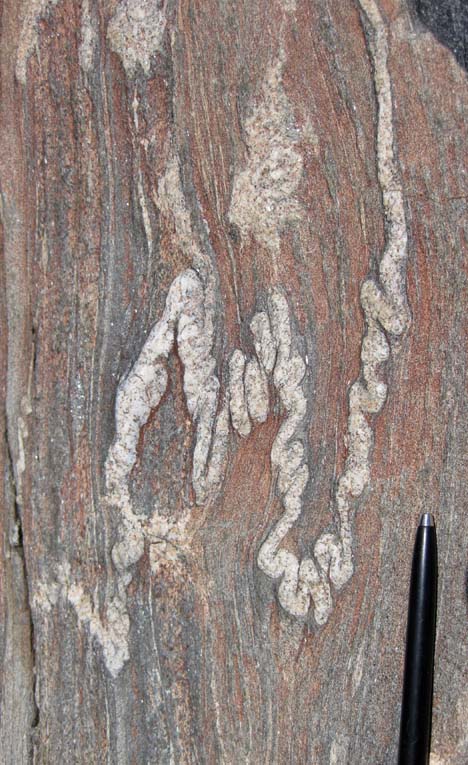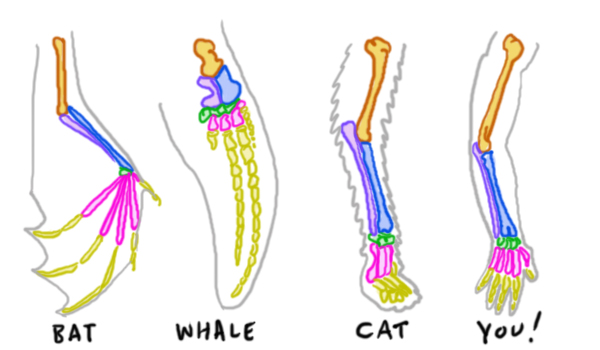Over the weekend, I launched a new initiative on Facebook to assist my friends in learning about scientific matters that they are interested in. I want to serve society in combating science illiteracy, and I think one way I can do that is to solicit questions or topics from those who want to learn more, and use those as a springboard for discussion. It’s time for me to let my social media network including you, dear reader, drive the content of the blog. I’ve set up a simple Google Form to allow anyone to submit questions anonymously.
Here are the first two questions, and my responses:
1) Why do geologists get so excited about folds?
This is a question that is entirely within my wheelhouse, since folded rocks are one of the most prominent features of this blog. I think I find them so fascinating because they are so counter-intuitive to basic human experience. I mean, here is a rock, a solid thing that would hurt us if it hit us on the head, and yet it clearly displays evidence that it has flowed as a soft, putty-like substance. To reconcile these two facts, we have to think beyond our normal experience. This is what science is so useful for, of course – systematic, empirical study allows us to escape our quotidian Ape Brain and come to terms with nature as it really is. Much of what science has revealed is counter-intuitive: Continents move. The Earth orbits the Sun. Our ancestors were fish. Quarks exist. The universe is vast.
When we allow the rocks to deform under higher temperatures than we can handle, at pressures much greater than we can survive, or for time spans much longer than our ephemeral lifetimes, the stiff, hard rocks can behave in astonishing ways. Rocks can flow. I think folds show this most clearly, though metaconglomerates and shear zones make the point in a different way. The realization that rocks can flow is fundamental: It’s a thought that forces us to change our assumptions about physical conditions, about the passing of time. It allows us to conceive of mantle convection. It allows us to imagine the formation of mountains as a dynamic process. It’s essential to understanding how the Earth works.

2) Why are some people born with tails, excessive amounts of body hair, and even what appears to be animal hands and feet?
The short answer to this one is “humans are animals.” We are creatures of flesh and blood, made of the same atoms and programmed by the same genetic code, as everything else on Earth. Ultimately, every living thing on this planet is a relative, though some are closer relations than others. Humans are apes, descended from tree-dwelling shrew-like critters, which were descended from hairy reptiles, which came from amphibians, which are basically fish that learned how to walk. We bear the marks of this extraordinary ancestry in our bodies. Our skeletons are built on the same basic body plan as every other mammal, but modified to allow us upright posture and big brains. It’s not a perfect arrangement: women’s hips are barely big enough to accommodate massive-headed babies to be born. We are plagued by lower back pain due to the S-shaped curve in our spine that animals like chimpanzees or hyenas lack. But in spite of the less-than-ideal tweaks that make use unique, the shared affinity is hard to dispute:

One of the most fascinating classes I took in college was Developmental Biology, the study of how a single fertilized egg grows into a whole organism, with many diversified cell types. Though developmental biology is not my professional specialty, I think I can make some general comments toward answering the question. In our mothers’ wombs, embryos grow according to tried-and-true developmental routines, mediated by biochemistry. The amount of hair is a function of how much the genes for hair growth are “expressed” (that is, copied and enacted by enzymes). People that have a lot of hair might (1) have genes that say “lots of hair” or (2) they might just have vigorous expression of the same genes that in someone else might result in less hair. So there are the instructions (genes) and then how frequently those instructions are read and enacted (regulation). We probably carry all sorts of genes that were useful to our non-human ancestors that are now “along for the ride” without being expressed as active blueprints for our development. Other inherited genes might be doubled-up or tripled, and that extra expression might result in very different effects in humans compared to non-human animals. So a gene for making hair follicles for instance, might be increased or decreased, to dramatic effect.
Another factor to consider is the presence of biochemical gradients. The length of toes, fingers and the backbone may be controlled by biochemical gradients that run from front to back (or top to bottom, or left to right). Let’s say there is some hypothetical chemical that is more concentrated toward one end of the growing embryo than the other end. When the concentration of this chemical (shown in purple in the sketch below) is high, the developing embryo starts making “head” stuff by turning on “head” genes, but if the concentration is low, the “head” genes are kept quiet, and instead, “tail” genes are turned on.

The embryo stops growing one of these body parts when its chemical surroundings change. There are dozens of ways that could happen, but let’s just imagine what happens when something goes wrong, and the chemical gradient is altered in some way. Maybe it’s too strong, or maybe it fades off sooner than it should, or maybe it increases, then decreases, and then increases again. The development of the embryo will react to those changes, and toes might be too short as a result, or the pieces of the tailbone might tack on additional material, extending them to be longer than they would otherwise have been. Giraffes have the same number of vertebrae in their necks as humans do; they’re just a lot longer. Or perhaps the number of pieces of tailbone can be changed. Repeating segments is an easy recipe for evolutionary variation. Just ask the centipede, the boa constrictor, or the polycheate worm.
If there is some environmental change, it too could alter the gradient, or the reception of the growing embryo to the gradient. For instance, there is a medication called thalidomide that pregnant women used to take to combat morning sickness, but it changed developmental conditions so that many of their children failed to fully develop their arms and legs, being born with paddle-like appendages instead. The addition of something like thalidomide alters the developmental environment, and this is why it’s so essential for pregnant women to protect themselves from substances which would hurt the embryo’s development.
The tailbone (coccyx) is basically the end of the spine, and it shows the same pattern as the rest of the backbone: a series of segments analogous to vertebrae, but tapering off to a point. Depending on who you look at, you may find three segments to the tailbone, or four, or five, fused together to a greater or lesser degree. This variation is a reflection of either the genes of the individual, or else variation in the strength of some developmentally-relevant biochemical gradient as the embryo is growing. That variation is an observation which gives us an insight into the source of developmentally-induced variation in humans – the sort of conditions that might result in people having characteristics like those in the question. A non-human example is using the ancestry of the chicken to turn the bird “back” into a dinosaur. It just takes a few tweaks on what’s already there to create something that looks a lot more like a Compsognathus than a dinner.
The diversity we see in our human brothers and sisters is a reflection of our collective animal ancestry. It shouldn’t surprise us to see that some people have tails or extra hair, because we are descended from animals that had lots of hair and had tails. What would be truly weird is if something showed up that wasn’t in our evolutionary heritage: an unprecedented novelty like a set of wings growing out of our backs, or antennae sprouting from our foreheads. Don’t hold your breath for either of those to show up any time soon.
That’s all for this first installment of “Q&A.” If you have a topic you want me to explore, use the Google Form to submit your questions anonymously.

